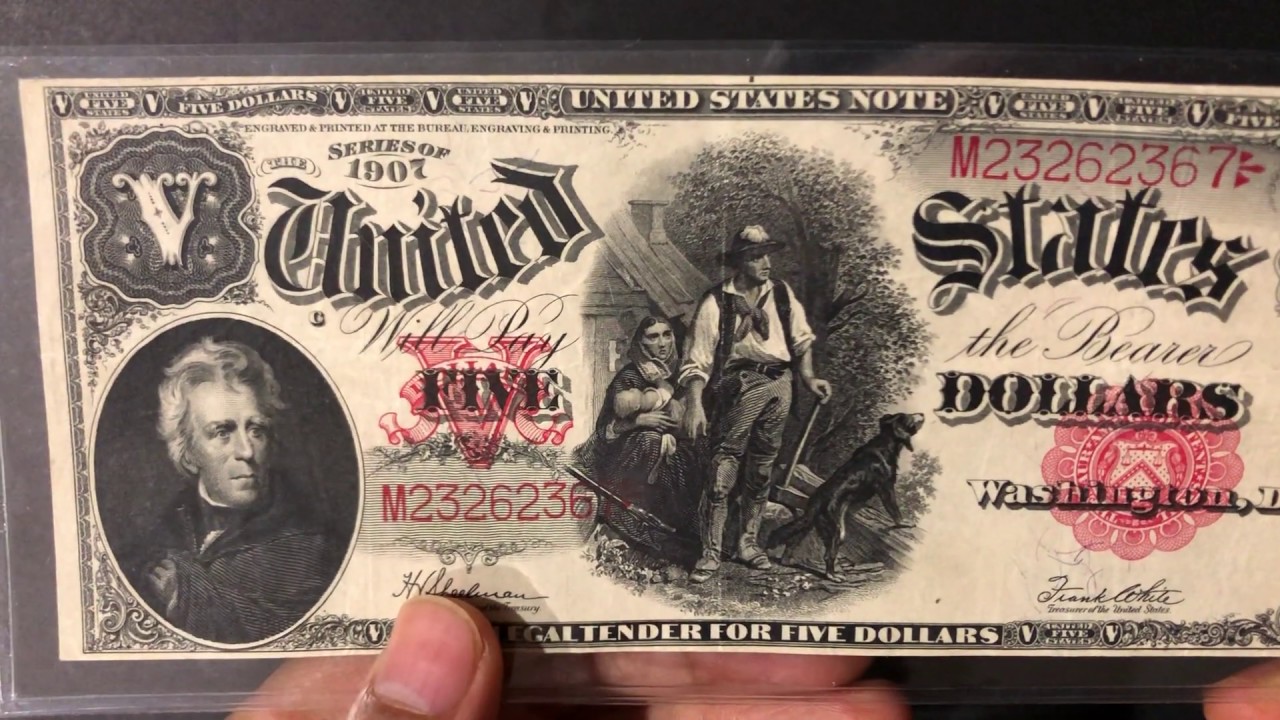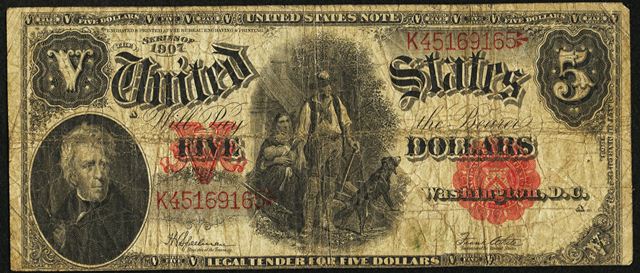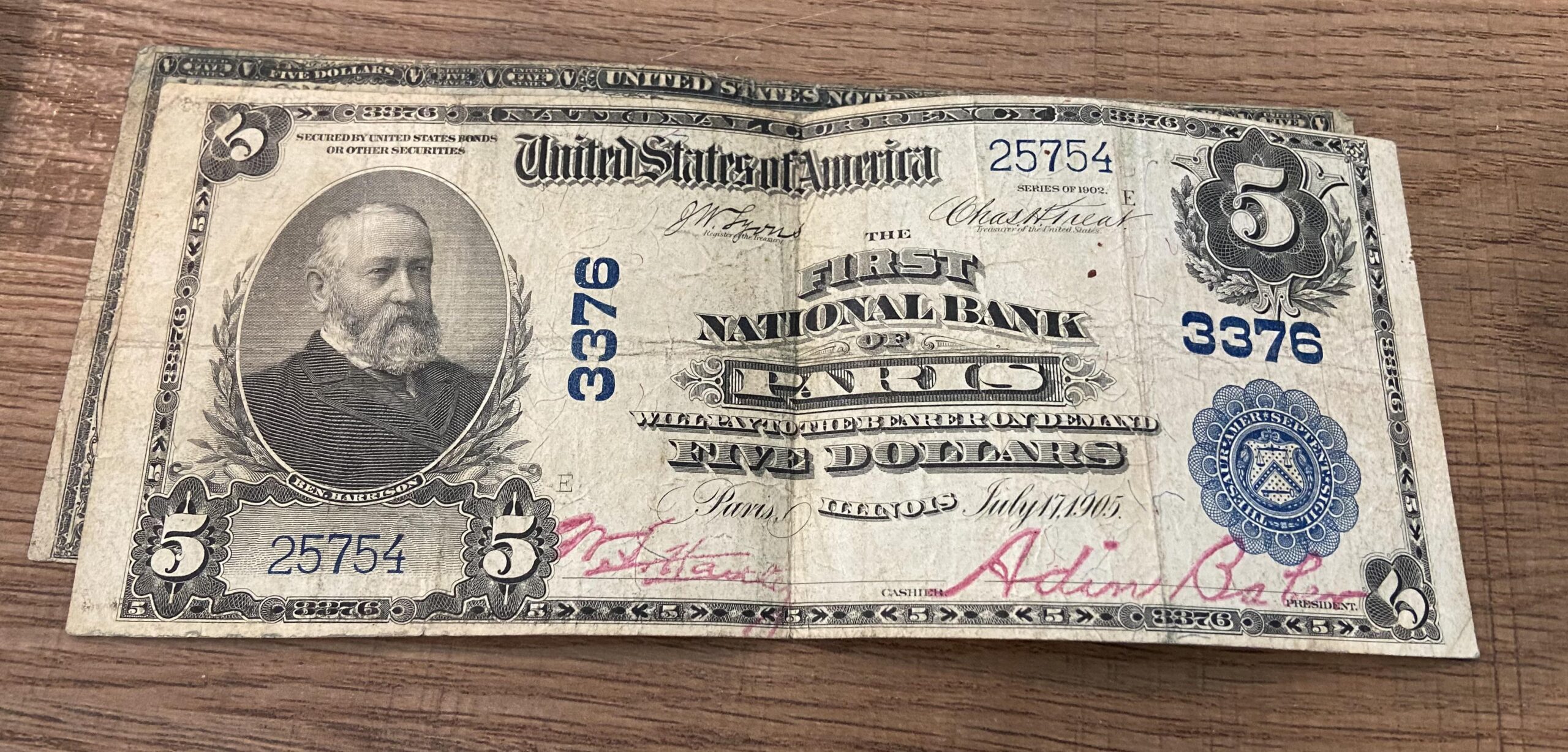If you’ve stumbled upon a 1907 5 dollar bill, you might be wondering about its worth and historical significance. This bill, part of the Series of 1907, is a large-size note that has become a fascinating collector’s item. With its iconic portrait of Andrew Jackson and unique features like the image of a pioneer family with a man holding an ax, the 1907 five dollar bill is much more than just a piece of currency.
You’ve inherited one or come across it in your travels, understanding its value can provide insight into its status as both a piece of history and a collectible item.

In this article, we’ll dive into the history, rarity, and grading of this bill to help you assess its worth, from general $5 bills to the rare varieties.
The 1907 $5 Bill: A Glimpse into History
The 1907 5 dollar bill is commonly known as the “Wood Chopper Note” due to the image of a pioneer family, including a man wielding an axe. This distinctive design sets it apart from other bills of its time.
The Series of 1907 was a transitional series, marking a significant shift in U.S. currency design and production.
The bill features the portrait of Andrew Jackson, the 7th president of the United States, who is remembered for his role in shaping American history.
Jackson’s image appears prominently on the front of the note, accompanied by intricate details such as the red seal and blue serial numbers.
This note is classified as a Legal Tender Note, a type of currency that was backed by the U.S. government, ensuring it was accepted for all debts, both public and private.
Another reason this bill stands out is due to its relatively large size compared to modern currency.
The 1907 $5 bill measures 7.42 inches by 3.12 inches, making it a considerable size for collectors. This historical size, combined with the unique design and the use of early printing technology, contributes to the bill’s collectible value.
Condition and Value: What is the 1907 $5 Bill Worth?
The value of a 1907 five dollar bill depends on several factors, most notably the condition of the note. While the face value of this bill was originally $5, its worth has significantly appreciated over time. It’s important to understand the grading system for bills to accurately assess their value.

In general, a $5 bill from 1907 in circulated condition will be worth more than its face value. The value increases depending on how well the bill has been preserved.
For example:
- Very Good Condition: A 1907 5 dollar bill in this condition will typically be worth around $120. The note shows considerable wear, but it is still identifiable and readable, with minor creases and discoloration.
- Very Fine Condition: A bill in this grade will typically fetch around $225. These notes have been circulated but are in relatively good shape. They show signs of use but retain their crispness and overall integrity.
- Extremely Fine Condition: A note in extremely fine condition can be worth about $420. These bills have small signs of wear, such as light creases or folds, but they remain bright and crisp, with almost all of their original features intact.
- Uncirculated (MS 63): The highest grade for a $5 bill is uncirculated, with no signs of wear. A 1907 five dollar bill in MS 63 condition can sell for around $750 or more, depending on the exact quality.
The key takeaway here is that the condition of your bill directly influences its value. If you have a 1907 5 dollar bill that has been well-preserved, it may be worth considerably more than its face value.
Rare Varieties and Their Significance
Not all 1907 five dollar bills are created equal. Some varieties are much rarer and more valuable than others.
One of the most coveted variations is the 1907 $5 bill featuring the signatures of Napier and Thompson, two officials from the U.S. Treasury at the time.
- In very good condition, this rare variety is worth about $185.
- In very fine condition, the bill’s value can reach $650.
- In extremely fine condition, the value increases to around $950.
- An uncirculated bill in MS 63 condition can fetch as much as $1,750 or more.
Because of its rarity, the 1907 $5 bill with the Napier and Thompson signatures is highly sought after by collectors.
If you own one of these rare bills, it is recommended to place it in a large-size currency holder to ensure its preservation.
Common Mistakes and Errors: Why It Matters
When it comes to collecting five dollar bills, errors and misprints can make a huge difference in value. Error bills are rare and often more valuable than their correctly printed counterparts. Common printing errors on the 1907 series $5 bills might include:
- Misaligned serial numbers: If the serial numbers on the bill are printed off-center or poorly aligned, it can increase the bill’s rarity and value.
- Overprints: Occasionally, bills will feature extra stamps or markings, which are mistakes that could enhance the bill’s worth.
- Misprinted denominations: Errors in the denomination number can be particularly valuable.
If you believe your 1907 5 dollar bill may have an error, it’s a good idea to consult an expert for a professional evaluation. Even a small mistake in the printing process could make your bill worth significantly more.
The Grading System Explained: How to Evaluate Your Bill
To properly evaluate the worth of your 1907 $5 bill, you’ll need to understand the grading system used by currency professionals.

Currency grading is essential in determining the market value of a bill and helps buyers and sellers agree on a fair price.
- Very Good (VG): Bills in this category show obvious signs of wear but are still in one piece and legible. They may have creases, folds, and minor tears.
- Fine (F): These bills show clear signs of circulation but are in relatively good condition, with slight damage and discoloration.
- Extremely Fine (EF): These bills show minimal signs of use and maintain their crisp appearance with only slight creases or folds.
- Uncirculated (UNC): Bills with no signs of wear and tear. They are as fresh as the day they were printed and have not been used for transactions.
The higher the grade, the more valuable the bill becomes. If you are in possession of a 1907 5 dollar bill and are considering selling it or adding it to your collection, it’s essential to have it professionally graded for the most accurate valuation.
How To Protect and Preserve Your 1907 $5 Bill
If you own a 1907 5 dollar bill, it’s crucial to take steps to protect it. To ensure the longevity and preservation of the note, store it in a protective holder or album specifically designed for currency.
Avoid exposing the bill to direct sunlight, moisture, or extreme temperatures, as these can cause fading and deterioration.
Additionally, handling the bill as little as possible is important. If you must handle it, make sure to wear cotton gloves to prevent oils and dirt from transferring to the note’s surface.
Conclusion: The 1907 5 Dollar Bill and Its Enduring Value
The 1907 5 dollar bill is a piece of history that has stood the test of time. Its distinctive design, featuring Andrew Jackson and the iconic “Wood Chopper” image, makes it a prized collector’s item.
Depending on the condition and specific variety of the bill, its value can range from a few hundred to over a thousand dollars. The key to maximizing the worth of your $5 bill lies in proper grading, careful handling, and understanding the factors that contribute to its value.
You’re a seasoned collector or a curious enthusiast, owning a 1907 five dollar bill is a unique and exciting experience.
Keep in mind the importance of preserving your bill, and if you suspect it might be a rare or error bill, don’t hesitate to have it professionally evaluated. In today’s market, these historical notes are a reminder of a bygone era and are sure to remain valuable for years to come.
